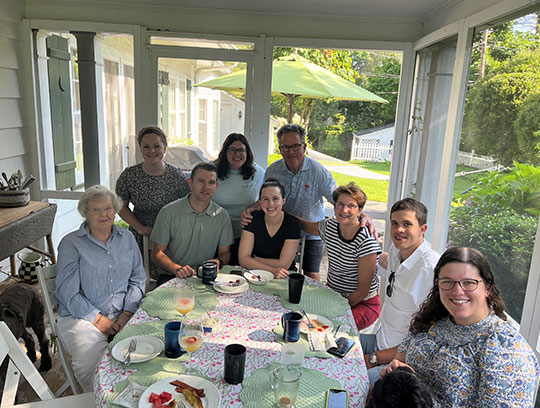Throughout her 40-year career in technology, Lewis Board Member Dawn DePerrior has seen, experienced, and learned a lot. She’s lived through mobile phones that were bigger than a brick, 1980s power suits with linebacker-esque shoulder pads, and many years of being the only female in the board room.
Lewis Leadership in Action Spotlight: Board Member Dawn DePerrior
Leading with care in a data-driven world
While working for prestigious companies and institutions such as Ernst & Young, the University of Rochester Medical Center, and Constellation Brands, DePerrior led all aspects of information technology, including business transformation, cyber security, data analytics, mergers and acquisition integration, and finance. She has spearheaded change initiatives that have revolutionized the ways businesses engage with customers, safeguarded data against breaches and cybercrimes, and implemented integrated electronic medical records programs.
Yet despite her extensive resume and distinguished accomplishments, DePerrior firmly believes that there’s more to leadership than a collection of awards and impressive titles. That’s why DePerrior’s favorite Lewis Leadership in Action Principle is “No one cares how much you KNOW—until they know how much you CARE.”

To get people to accept change, we need to listen to their concerns and address them. This requires empathy.

President Teddy Roosevelt may have authored this famous phrase, and Lewis leadership selected it as a 2024 Leadership in Action Principle, but DePerrior has spent her entire career putting these insightful words into action. DePerrior’s purposeful prioritization of care before knowledge may seem surprising coming from a tech exec who is admittedly driven by data, however, her candid perspective on many topics—technology, change management, empathy, and being the only woman in the room—is both refreshing and thought-provoking.

Strategy + Technology + Change Management = Success
DePerrior has managed many transformative technology projects during the past four decades—yet she is the first to say that she doesn’t see herself as a technologist. Rather, DePerrior’s career has focused on driving strategic change powered by technology. At a glance, the difference between strategy-driven versus technology-driven may seem like splitting hairs. Tomato-tomahto, right? Not quite. DePerrior is quick to point out that her successful technology endeavors (as a non-technologist) are the result of strategy plus technology—with a dose of change management magic.

Dawn DePerrior visits Lewis Employees in the field
DePerrior explains, “When you lead business change projects that are rooted in technology—even when you know the technology works—the success of the project still hinges on whether you can get people to change. And that requires strategy.” She continues, “The topic of strategic change is near and dear to my heart. As humans, we resist change. This is why technology will not automatically succeed on its own. My experience has been that change projects require clear, consistent, bold executive sponsorship—and a commitment to navigating the nuances of change management.”

Demystifying Change
While DePerrior admits that she finds change very exciting, she also concedes that change can be quite scary for some.
In their Forbes article, “The Four Principles of Change Management,” Dana Miranda and Cassie Bottorff highlight Dr. John Kotter, Harvard Business School professor and a prominent thought leader in change management, and his eight steps to change management. Kotter’s recommendations include: creating a sense of urgency; building a guiding coalition; forming a strategic vision and initiatives; enlisting volunteers; enabling action by removing barriers; generating short-term wins; sustaining acceleration; and instituting change. To accompany these eight steps, Kotter outlines four change principles aimed at building consensus, investing in improvements, appealing to the head and heart, and engaging both management and leadership skills.
DePerrior’s leadership style aligns with Kotter’s conditions for effective change management, especially when it comes to building strong teams, instituting change to benefit the entire system, and appealing to both the head and heart.

Making the Case for Empathy
It may come as a surprise that someone so devoutly data-driven and tied to technology is also a staunch champion of empathy. Despite these somewhat opposing philosophies, DePerrior has relied on empathy as a valuable leadership tool throughout her career—even in traditionally male sectors where empathetic leadership was routinely discounted.

Dawn, spending time with family
For many years, empathy was regarded as a sign of weakness instead of a strength and thus not a respected leadership trait. Research studies have indicated that women are more empathetic by nature, so there was frequently an assumption that women were too emotional to be strong, decisive leaders.
DePerrior dismisses that antiquated notion and views empathy as an important component of coalition-building, especially during times of change. “To get people to accept change, we need to listen to their concerns and address them. This requires empathy.” A natural “people person,” DePerrior is sincerely interested in learning about people and what’s happening in their lives. Listening allows her to know and understand her teams on both professional and personal levels. Listening builds trust—and trust helps to build high-performing teams. This critical sequencing of caring, listening, and building trust is something that has served DePerrior well.

Empowering Female Leaders to Realize Their Potential

Listen to those who are encouraging you to do something. They probably see leadership qualities that you don’t recognize in yourself. Take the risk.

Thinking back on the early years when she was often the only female executive in the room, DePerrior acknowledges that she’s still a bit of a unicorn. “I don’t know what happened to the women who started with me in technology in the 80s, but they seemed to disappear along the way.”
Women in industries like vegetation management, construction, and manufacturing still frequently find themselves to be exceptions in spaces that are traditionally populated by men. There are various ways that women handle these situations. DePerrior employed her own approach and tried to NOT see the differences in the room, and NOT worry that there weren’t other people who looked like her. By centering her purpose, DePerrior was able to tune out the differences and focus on her contributions to the mission.
DePerrior acknowledges that this approach may not work for everyone. For many women, it’s still a daily tightrope: be empathetic, but don’t show emotions. Listen to others, but be decisive. Share vulnerability, but be resilient.
Despite these minefields of contradiction, DePerrior advises women to take the leap. “We are often unaware of our own skills, our own leadership potential. Others may see promise that we’re overlooking, so trust when people ask you to lead. Listen to those who are encouraging you to do something. They probably see leadership qualities that you don’t recognize in yourself. Take the risk. And uplift others who are on their own journey.”

Serving Lewis
Supporting others is second nature for DePerrior. Raised to give back to the community, she has served on numerous boards across multiple sectors and is invested in these opportunities. Admittedly selective about board service, DePerrior researches the culture, purpose, and mission of an organization before agreeing to a position. In addition to her role on Lewis’ Board, she is currently a board member for several organizations in Western New York, including the Villa of Hope, Greater Rochester Regional Health Information Organization (GR-RHIO), and Evans Bank.
DePerrior’s passion for Lewis is shared by her Board colleagues and collectively rooted in their deep commitment to the mission. “One of our favorite parts of every Board meeting is when we hear from the great leaders within Lewis about what they are working on. We appreciate this opportunity to learn, support, and offer input.” By creating a safe environment at the Board level, Lewis leaders are able to share hurdles on the horizon without fear of judgement or negative consequences. DePerrior believes that, without a safe, empathetic environment, there is a tendency to keep secrets and hide risks, which can put people and processes in jeopardy.
Looking ahead, DePerrior is incredibly excited about the growth potential at Lewis—growth in the industry, growth for Lewis customers, and growth for Lewis staff. “The Board and Executive team truly believe that every individual at Lewis has an opportunity to contribute at the next level if they want to… and the level after that, and the level after that.” For her part, DePerrior looks forward to supporting that growth by leveraging her own years of experience, change management acumen, and strategic skills—all while proudly leading with care.

Successful technology endeavors are the result of strategy plus technology—with a dose of change management magic.




